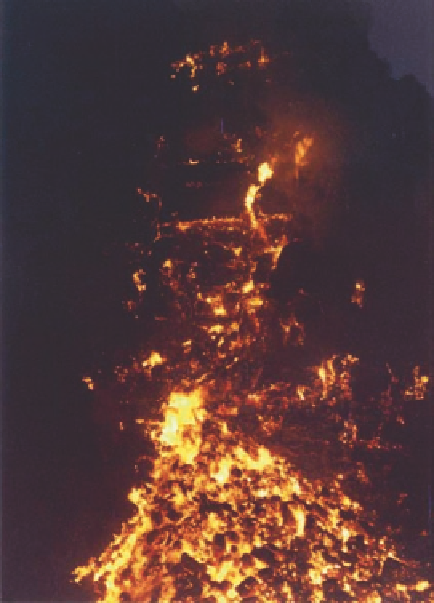Geology Reference
In-Depth Information
Top of bench
Coal seam exposed (working face)
15 m
Bedding planes and joints
(cleat) in coal seam
Bottom of bench
Debris cone
Figure 5.1.8. Coal fire, approximately 20 m high; note how the direction of burning is controlled by the principal
joints in the coal seam, Jayant opencast coal mine, Singrauli coalfield, India. Photo by Donnelly 2000.
Slope Failure at El Cerrejón Zona Norte, Colombia
Coal is mined throughout Colombia from artisanal mines located in the Colombian Andes (Donnelly et al., 2001a,b)
to large-scale opencast mining operations near the Caribbean coastline. El Cerrejón Zona Norte, an opencast coal
mine, is located in the Guajira Peninsula, in northeast Colombia. The Cerrejón coal basin is approximately 50 km
long and 5 km wide and it contains a 900m thick non-marine succession of coal-bearing strata with approximately
55 coal seams; some are 26m thick (Walker, 2000). In 2000, a field trip to El Cerrejón Zona Norte revealed coal
fires in the opencast coal mine. These fires generated plumes of gas, dust and smoke, creating potentially irritant or
harmful conditions in parts of the mine. In one instance, a large slope failure was anecdotally reported to have been
caused or exacerbated by spontaneous combustion, resulting in the loss of large quantities of coal reserves along
one side of the opencast mine (Figure 5.1.9). Similar examples of the failure of opencast slopes and benches caused
by coal fires have been observed in China (Figure 5.1.10).
Spontaneous Combustion and Spoil Heap in Barnsley, Yorkshire Coalfield, England
Colliery spoil heaps in Britain are particularly susceptible to burning (Figure 5.1.11). Barnsley is located in the
Yorkshire coalfield in northern England. This coalfield has a long and complex mining legacy. Bell and Donnelly
(2002, 2006) documented two colliery spoils heaps, covering a total area of approximately 49 ha, requiring
rehabilitation so that the sites they were on could be restored for the provision of industrial development and public
lands. The total volume of the spoil heaps was around 4 million m
3
. The moisture content ranged from 6 to 13%,
being greater in the finer materials. Most of the spoils materials were sand grade with traces of pyrite.
When the top layers of the spoils were stripped during rehabilitation in 1985, hot spots were encountered with
temperatures of approximately 600 °C, and occasionally reaching 900 °C (Bell and Donnelly, 2002). This resulted
in a number of operational constraints and logistical challenges, including melted tires on plant machinery, stalled
engines on the scrapers, and the rescue of site equipment and operators. To mitigate the colliery-waste fires, the
spoil was removed in thin layers around 300 mm thick and subsequently compacted. This method reduced the
ground temperature significantly and enabled the work to continue. Hot spot areas were covered with clay which











